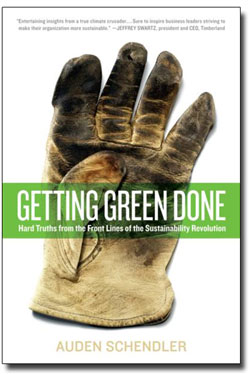|
| ||
| ‘Getting Green Done’
by Allen Best In 1999, Auden Schendler went to work for the Aspen Skiing Co. with the mandate to improve the environmental performance of the company’s four ski areas and ancillary properties. He thought he already knew a lot, especially about saving energy. He had crawled amid the mice droppings under trailers to install insulation, then worked for energy guru Amory Lovins at the Rocky Mountain Institute. From Lovins and others, he had heard that saving energy should be easy, because it saved money – and who didn’t want to save money? But what Schendler learned in green-leaning, well-heeled Aspen was that the real world only occasionally squared with the PowerPoint presentations. If that’s the case in Aspen, imagine the difficulties in the other real world, he suggests in his book, Getting Green Done: Hard Truths from the Front Lines of the Sustainability Revolution. Instead of technological barriers, Schendler found “human barriers.” Some people heard the word “environmental,” which is part of his title, and blanked out all of his economic arguments. Another rift that had to be bridged was a cultural one. He was viewed with suspicion by the blue-collar mechanics whose aid was crucial to implement his changes. Hotel and other managers at times also had good reason to resist. But even corporate officers distrusted his claims of saving money. “The sustainability gurus say that all obstacles can be overcome. But they generally are talking to people like me who consider it an honor to plunge a low-flush toilet,” Schendler says. “They haven’t had a lunch with a restaurant manager whose career depends on his perception of an uncompromised product.” Schendler had that lunch, and it was at the gilded Little Nell, the Aspen Skiing Co.’s five-star hotel. Aspen uses two to four times as much energy per capita as the U.S. average, and the Little Nell is even more energy intensive. Schendler figured that trimming energy use would be akin to shooting fish in a barrel. But in his first shot – installing compact-fluorescent bulbs – he missed. The manager had the expensive bulbs thrown in the trash, fearful of losing the coveted five-star rating when an auditor discovered lighting that was too dim. What Schendler saw as a money-saving opportunity, the hotel manager saw as a money-losing opportunity. The PowerPoints never mentioned this. Not until he got to the Little Nell’s parking garage did Schendler notch a win, and only then because of a grant from a nonprofit and the intercession of Aspen Skiing’s then-chief executive, Pat O’Donnell. “I came out of the nonprofit sector ready to kick some ass, loaded with tons of ammo from the world of sustainability theory,” Schendler writes, “but at the Nell, during my first project, I came over the top of the trench and got machine gunned because my ideas weren’t grounded in reality – they were fueled by idealism and hope. Those are good traits, but they carry only so much weight in corporate boardrooms.” Since that initial despair, Schendler has had more consistent successes, including one of the first 11 buildings in the world certified under the U.S. Green Building Council’s Leadership in Energy and Environmental Design (LEED) standards. Don’t be impressed, says Schendler. That bar was originally set pretty low. Now raised higher, LEED and other certifications are not the real point. Whether buying wind energy or creating buildings, he contends, achieving true reductions in greenhouse gases is much harder than it looks. But these bottom-up efforts to reduce energy, if difficult, are essential in giving companies like the Aspen Skiing Co. credibility to lobby for truly powerful top-down policies. The most important thing the Aspen Skiing Co. has ever done, he declares, is file a legal brief on behalf of Massachusetts, which won a 2007 Supreme Court decision forcing the Environmental Protection Agency to evaluate whether carbon dioxide emissions and five other greenhouse gases should be regulated under the Clean Air Act. The EPA recently announced that it does intend to regulate emissions of the greenhouse gas. Somewhat contrary to his own argument, though, Schendler holds that saving energy to save money isn’t sufficient on its own to push the changes that are needed in corporate America. There must be, he insists, a moral imperative to reduce energy use or otherwise eliminate greenhouse gas emissions. In making these arguments, Schendler writes forcefully. He is above all convinced of the righteousness of his cause. I happen to think he’s mostly right. Still, his rhetoric can be preachy, and his logic somewhat tortured. He attempts to put distance between contemporary climate crusaders and environmental crusaders of the 1970s. He knocks the environmentalism of “a secular religion.” Then, without a hint of irony, he argues that climate change offers “the opportunity to participate in a movement that – in its vastness of scope – can fulfill the human need of a sense of meaning in our lives.” More puzzling, he admits that the greenhouse gas emissions of the Aspen Skiing Co. have actually grown during his time there. The, he says, is from increasing volume of business but also the increasing energy intensity of the business. That one sentence shrieked for more thoughtful reflection and analysis than it got, perhaps displacing some of the call to arms. That said, Getting Green Done is loaded with anecdotes and one-liners, and is sometimes even funny. It is easy to read and, if not the final word on sustainability, offers many points to consider. •
|
In this week's issue...
- May 15, 2025
- End of the trail
Despite tariff pause, Colorado bike company can’t hang on through supply chain chaos
- May 8, 2025
- Shared pain
Dismal trend highlights need to cut usage in Upper Basin, too
- April 24, 2025
- A tale of two bills
Nuclear gets all the hype, but optimizing infrastructure will have bigger impact


